Tanushree Podder's Blog, page 2
July 3, 2016
Stop on the streets
Whoever dreamed of a day when street food would crawl into the hallowed pages of Michelin Guide, which has hitherto restricted its list to classy restaurants! Well, Hong Kong’s street food has just managed that impossible feat. As many as 23 eateries in Hong Kong have been included in the 2016 edition of Michelin Guide, which has created a new category for street food. In short, the street food of Hong Kong has made history.
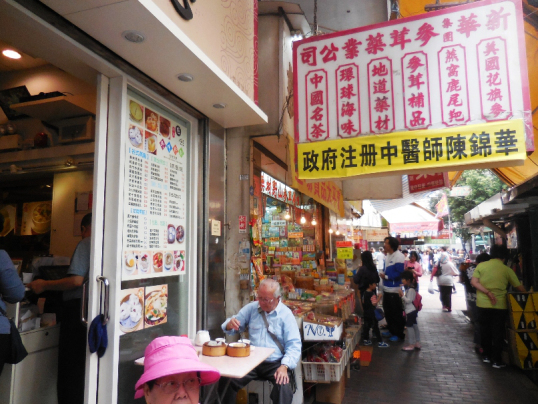
Food stalls in Old Quarters
Fried pork-fat noodles, delicious Thai rice noodles, exotic soy-sauce-coated octopus, unpretentious rice rolls, Shanghainese pork buns, delectable burgers, fragrant satay, Korean fried chicken, mild Cantonese puddings, tantalising tofu pudding, famous Cantonese waffle, popular wonton noodles — you name it and it’s there on the list.
Popular, tasty and pocket friendly, street food across many Asian countries can give the classier restaurants a run for their money. But they have been denied their rightful place, till now.
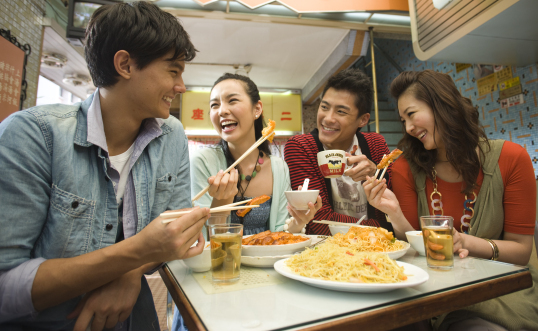
Many takers
Like Singapore and Malaysia, the street food of Hong Kong has many fans. The vast repertoire is possibly one of the factors that have highlighted the Hong Kong street food. In the recent years, many adventurous tourists have begun crowding the tiny outlets or food carts to sample the fare that have earlier been known only to the locals. So much so that the undisputed Tsar among chefs, Anthony Bourdain, has claimed that Hong Kong is the world’s best city for street food.
Hong Kong is indeed a cuisine cauldron; right from the Malaysian satay to the Cantonese delicacies to Vietnamese and Korean fare, the city has adopted every kind of Asian cuisine.
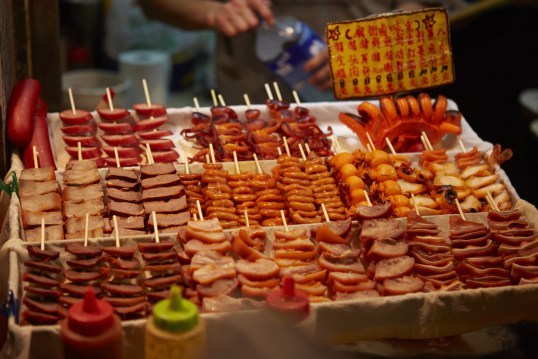
an array of skewered meat
Some districts in Hong Kong are more famous for their street food than the swanky restaurants in their neighbourhood. For instance, Mong Kok, which is reputed to be the world’s most crowded area, is famous for its street food. In the modest stalls there, you are likely to find the most delicious curried fish balls you’ll ever taste. The other neighbourhood popular for its offerings is Kowloon, where the night market draws hordes of people every night.
For an unforgettable experience, sample food at a dai pai dong (open-air street food stalls with discernible green-coloured kitchens), or a cha chaan teng (tea restaurant). These are no-nonsense type of eateries with cheap and tasty Cantonese cuisine. And, the boisterous setting is a bonus.
Sadly, these hectic and noisy places are a dying phenomenon, with just about a handful of them left in Hong Kong today. Some of the dai pai dongs, with tiny tables spilling over to the streets, began business during the 50s and catered to the working class. Unpretentious but popular food stalls still draw large working-class crowds to their cluttered tables during lunch hour.
The way forward
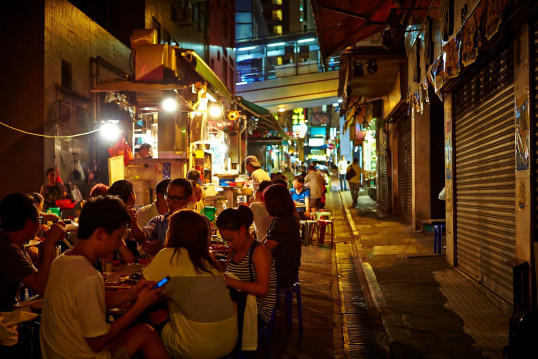
dai pai dong
In the past decades, they have acquired a reputation for being unhygienic traffic blockers, which is why the Hong Kong government is chary of renewing the licences. Many enterprising dai pai dongs have moved into ‘cooked food centres’, which are akin to food courts. Some have refurbished their eateries into tiny but attractive restaurants.
In a typical dai pai dong, you can smack your lips on classic Cantonese fare like fried pork-rib, stir-fried beef noodles, noodles with ground beef and egg in tomato broth, sweet & sour pork, crispy buns, and pork rice rolls.
The cha chaan teng, although a tea restaurant, also serves food. The name came about as they serve all kinds of tea.
Local cuisine as well as Western cuisine are available here at affordable prices. One is likely to find baked chicken pies, egg tarts and bo lo bao (pineapple buns) along with wonton noodles, scrambled egg-and-ham sandwiches, together with drinks like black tea, coffee, lemon tea, green tea and milk tea, which are popular among the locals. Surprisingly, you’ll also find Horlicks and Ovaltine, and a drink known as yin-yang, which is a blend of tea and coffee.
The gai dan zai deserves a mention while writing about Hong Kong favourites. The traditional egg waffle, sometimes called ‘eggettes’, rose to popularity in the 50s, and has remained so.
Next time you visit Hong Kong, visit the traditional dai pai dong for a thrilling hole-in-the-wall eating experience. Who knows how long these gastronomic icons will continue to serve those who want to enjoy the old Hong Kong!
(Published in Sunday Herald, July 3, 2016)
Filed under: Travel, Wine and Cuisine Tagged: baked chicken pies, Cantonese fare, cha chaan teng, crispy buns, dai pai dong, egg tarts, egg waffle, gai dan zai, Hong Kong, Kowloon, Michelin Guide, Mong Kok, pineapple buns, pork rice rolls, pork-rib, Street Food, tofu pudding, wonton noodles








June 21, 2016
Heart Warmers at Hong Kong
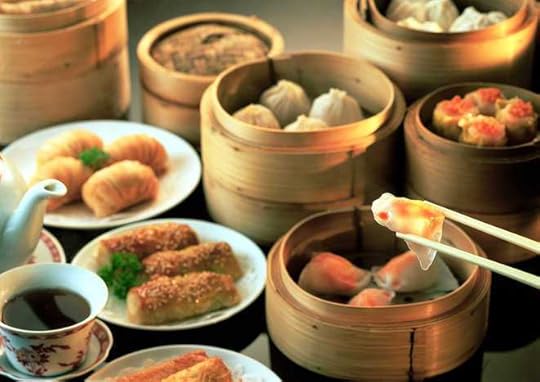
No visit to Hong Kong can be considered complete unless one has experienced the Yum Cha ritual. Simply translated as ‘Tea Time’, Yum Cha, can turn out to be an addicting experience. The closest equivalent to the ‘Elevenses’ and ‘High Tea’, Yum Cha is a Cantonese practice that has found its way across the world. The tea ranges from the ubiquitous jasmine tea to Po-Lay and Sau-May. These are sipped in a leisurely manner while an assortment of dim sums serves as accompaniment.

As to the invention of dim sum, stories abound. According to one of the versions, the delicacy was invented by an enterprising chef employed in the royal palace during the reign of Ching dynasty. The empress held a contest to encourage the innovative cooks to come forth with interesting snacks for her mid-morning tea ceremony. It is said the contest continued for more than a year, during which chefs vied with each other to present the most delicious snacks.
An amazing range of more than 2000 variations of the delicacy were produced. These were named dim sum.The words dim sum mean ‘heart warmers’. The steamed and fried versions of dim sum went on to become a rage with the royalty before making their way to the homes of the common people. Tea houses vied with each other in presenting the most innovative range of dim sum to their patrons.
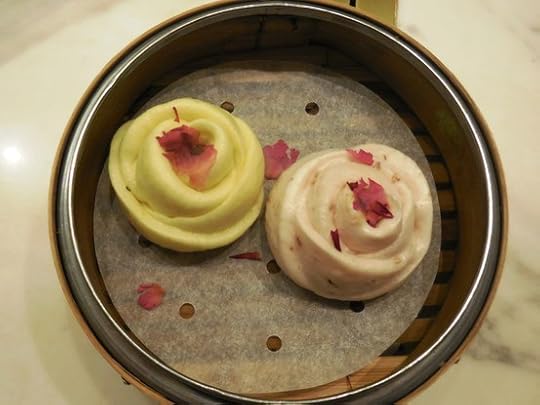
During the imperial times, tea houses served as important meeting places, where businessmen sealed important deals and gentlemen of leisure spent time to catch up with each other. Often these were used to settle disputes. Tea houses continue to remain in favour for the same reasons till date.
At Hong Kong, the practice of using Yum Cha for sealing important deals continues. Perhaps, it is the informal ambience coupled with the taste of comfort food that does the trick. Although, they have turned into noisy and busy places, the restaurants that serve Yum Cha are favoured by many businessmen for meeting their customers.Hong Kong has some of the most imaginative dim sum chefs.
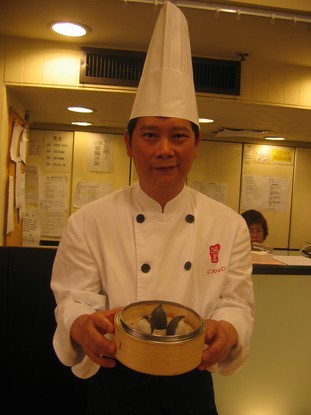
A chef with penguin shaped dim sums
While prawn is the most popular stuffing, there are dim sums with stuffings of pork, chicken or minced scallop. Herbs like ginger, coriander, and chives are used to create a unique flavour. Dim Sums come in two forms — steamed or fried. These also come in savoury or sweet avatars.
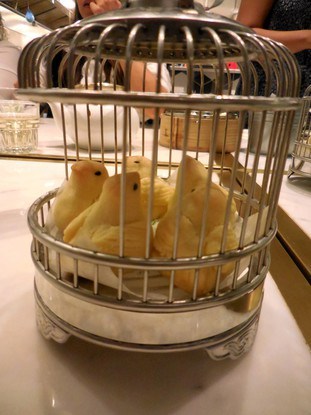
Creativity at its best can be witnessed in dumplings of different shapes like birds or penguins and rose petals
Most of the sweet dumplings are made with fillings of red bean paste. A rather delectable version comes as coconut snowballs and thousand-layer sweet cake with egg topping.These come with an amazing array of dipping sauces, which range from the conventional soy sauce and chilli sauce to the more exotic sweet cilantro sauce, ginger soy sauce, lime and fish sauce, or plum sauce.
Some of the most popular dim sums are the Har Gau, Dai chee gau, Xiao Long Bau and Cha siew bau. The vegetable and meat Siew Mai, pan-fried chives and meat dumplings, fried garlic prawn dumplings and sesame prawn are equally in demand from the discerning Yum Cha aficionado. Whatever be the choice, a Yum Cha experience at Hong Kong is a unique and unmissable one.
(Published in The Tribune, May 29, 2016)
Filed under: Travel, Wine and Cuisine Tagged: Cha siew bau, Ching dynasty, Dai chee gau, Dim Sum, Har Gau, heart warmers, Hong Kong, jasmine tea, pan-fried chives, Po-Lay, prawn dumplings, red bean paste, Sau-May, sesame prawn, Siew Mai, tea houses, Xiao Long Bau, Yum Cha








A tale of two cities
They’re two cities in the same country, just five hours apart by car — yet so different. While erstwhile Saigon, now known as Ho Chi Minh City, or by its initials, HCMC, wears its Western influence with aplomb, Vietnam’s capital, Hanoi, still retains a remarkably communist-era feel to it.

Map by Nilratan Maity. Not to scale
For a country ravaged by war, though, Vietnam has shown great resilience in recovering from its horrific past. Glimpses of the past can barely be seen, except in museums. What one experiences in Vietnam is a vibrant population, buzzing cities and miles of verdant fields dotted with conical hats in the countryside.
My journey began in Hanoi which is clearly a capital city. It was capital of French Indochina and then of Communist North Vietnam and remained a capital after reunification of North and South Vietnam in 1976. The city’s divided into two distinct parts — the Old Quarter and French Quarter. Colonial facades, tree-lined avenues, plush shopping arcades, luxurious hotels and boutiques populate the French Quarter while the narrow, labyrinthine lanes (collectively called 36 Streets) enliven the Old Quarter. For a traveller, there can be no bigger delight than frequenting both.
And those looking for the remnants of Vietnam’s communist past aren’t disappointed. Fluttering sickle-and-hammer flags, stern-faced policemen near key sites and blaring loudspeakers at street corners speak of the regimented life Hanoi citizens once led.
Nowhere is the regimentation more evident than when visiting the Ho Chi Minh Mausoleum. I joined a long queue of reverent locals eager for their rendezvous with “Uncle HO”. Bags were X-rayed, water bottles confiscated and strict instructions issued. Several white-uniformed soldiers kept a stern eye on the crawling queue.
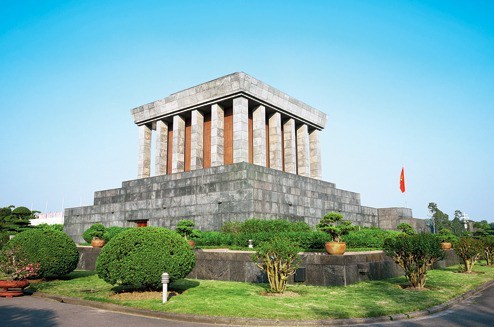
Vietnam’s revolutionary leader Ho Chi Minh may be long gone but his mausoleum in Hanoi is one of the city’s hottest tourist spots
A group of wide-eyed whispering students were hustled along with instructions to “keep quiet.” The snaking queue of visitors shuffled past the mummified body of a youthful-looking Ho. Someone whispered he’d just returned from his annual touch-up in Moscow where Russian leader Vladimir Lenin’s body is maintained by experts at a mausoleum in Red Square. A hushed silence, a few awed gasps and we were hurried out of the hallowed presence of the Father of Vietnam.
I ran across another group of whispering students near the giant stone tortoises at the Temple of Literature, the first Vietnamese university, which dates back to 1076. It was exam time and the children were patting the creatures for good luck.
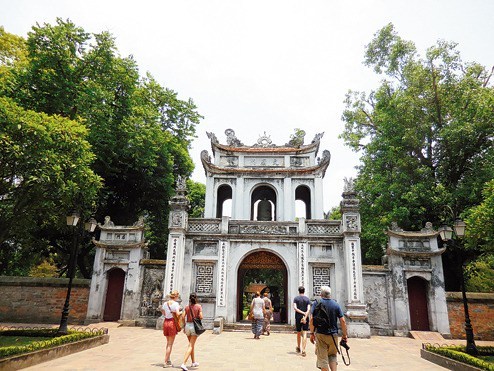
Hanoi’s Temple of Literature was an ancient centre of learning that dates all the way back to 1076
Photo: Tanushree Podder
Minutes later, hunger propelled me toward a horde of locals seated on plastic pavement stools. Slurping a bowlful of Pho, a rice-noodle meat broth that was delicious, fresh and inexpensive, I realised why Vietnamese cuisine is riding atop world culinary charts.
Then I was off to Hoan Kiem Lake, the city’s centrepiece and a popular spot for relaxing, where the proverbial golden dragon was spotted emerging from the water. Then, weaving my way through a crazily speeding tide of mopeds, skirting conical-hatted vendors, street-side diners and colourful cyclos, I made my way towards the Water Puppet Theatre to catch the unique show.
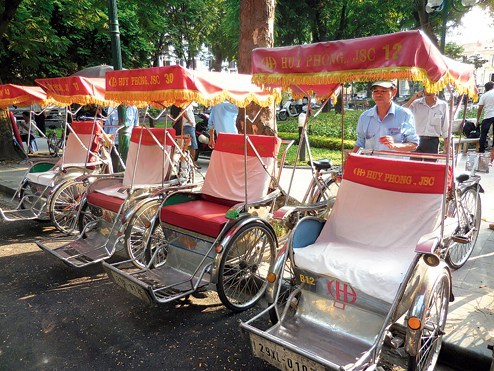
Colourful cyclos brighten up the capital’s streets and are a common way of getting around in the city at a leisurely pace
Photo: Tanushree Podder
Next morning, driving through miles of green paddy fields, it was not difficult to see why the foreign powers had coveted the country. Lush and lovely, Vietnam is an artist’s dream. Then I arrived in Ho Chi Minh City, where I was greeted by soaring skyscrapers, imposing architecture, bustling avenues and another two-wheeler tide.
Saigon, as it was known during the Vietnam War, is the backdrop for many novels about the conflict on which I had grown up. I knew the American side of the war, but then I discovered the Vietnamese version at the war museum and visited the infamous Cu Chi Tunnels, a labyrinth of underground living quarters and Viet Cong supply routes.
Other than a few grim reminders of those turbulent years, HCMC is a vibrant, bustling and happy place where tourists flock to sample the delectable cuisine and cruise down the Mekong River. Life here’s faster-paced, busier and more cosmopolitan than in Hanoi.
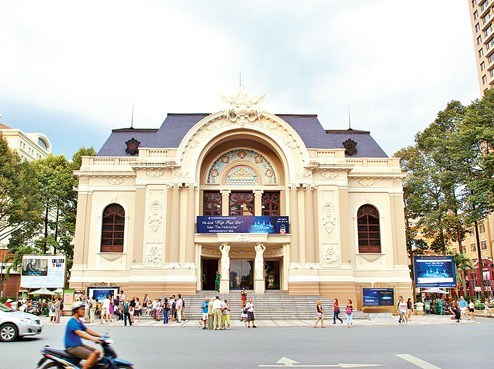
Ho Chi Minh City, with its strong French influences , boasts of architectural masterpieces such as the Opera House on Lam Son Square
The imposing Reunification Palace, the Saigon Post Office designed by Gustave Eiffel, the French architect who also designed the Eiffel Tower, the lovely Opera House on Lam Son Square, the impressive City Hall and the Notre-Dame Basilica built with red bricks imported from Marseilles are all architectural masterpieces, reminders of the city’s colonial past.
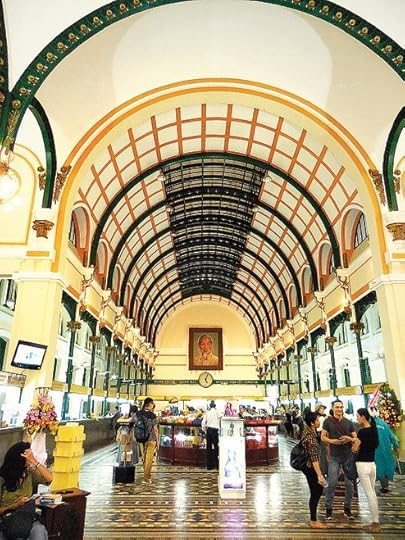
The erstwhile Saigon Post Office designed by Gustave Eiffel
Photo: Tanushree Podder
Hanging around the Saigon River, it’s impossible to escape the city’s youthful energy. Throbbing music sets feet tapping at every square which come alive in the evenings. HCMC has come a long way since the war ended, although it’s still possible to revisit those times. All one has to do is to step into the Continental Hotel where Graham Greene holed up to work on his book The Quiet American, or enter the Caravelle Hotel, the war correspondents’ watering-hole.
Competitive, brash, young, vibrant, irreverent — that’s what describes Ho Chi Minh City. Traditional, restrained — that’s Hanoi. That said, it’s difficult not to be charmed by both cities or come back untouched.
READY RECKONER
♦ How to get there: From Calcutta, both Ho Chi Minh City and Hanoi are one-stop flights away on Thai Airways.
♦ Where to stay: There are hundreds of affordable options. In Hanoi, staying in the Old Quarter is cheaper than in the French Quarter. In Ho Chi Minh City, try the five-star Hotel Continental or the three-star Sunland Hotel.
♦ What to do: Go on a cruise on the Mekong River, visit Halong Bay and the Cu Chi Tunnels. Savour the street food and Vietnamese coffee.
(Published in Sunday Telegraph, April 24, 2016)
Filed under: Travel, Wine and Cuisine Tagged: City Hall, Cu Chi Tunnels, cyclos, French Quarter, Graham Greene, Gustave Eiffel, Halong Bay, Hanoi, Ho Chi Minh, Ho Chi Minh City, Hoan Kiem Lake, Lam Son Square, Mekong River, Notre-Dame Basilica, Old Quarter, Opera House, Pho, Reunification Palace, Saigon, Saigon Post Office, Saigon River, Temple of Literature, Viet Cong, Vietnam,







May 17, 2016
A regal retreat
It’s a sleepy seaside town barely 200 km from the Thai capital. Hua Hin has pristine beaches, blue waters and it has somehow stayed off the map of the madding tourist crowds that flock to Pattaya and for more than a century Hua Hin has been a favourite haunt of the Thai royals and discriminating locals who’ve figured it’s a great weekend getaway. Although some expats have discovered the beauties of Hua Hin, it’s off the regular tourist beat.
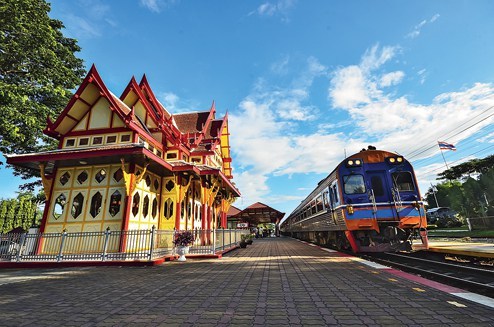
Hua Hin railway station’s classical-style Thai pavilion was built as a waiting room for royalty and is now a tourist sight in its own right..
Hua Hin makes an appearance in the history books in the 1830s when nearby Phetchaburi faced a killer famine and farmers began migrating from the area. As they headed towards the capital, they discovered a tiny fishing village sitting pretty on silky white sands. It was a rocky beach so they named it Samore Riang (rows of rock). It was later called Hin Riang, Lam Hin (stone cape) and, finally, Hua Hin (stone head).
The story goes that Prince Chakrabhongse, one of the royals, accompanied by a Russian nobleman came to the area on a hunting trip in the early 1900s and instantly fell in love with it. So much so that he built himself a beach villa, the likes of which had never been seen in the area.
Some time later King Rama VI visited the place and like the prince, he too fell in love with the beautiful and serene place and immediately ordered the construction of the Marukatayawan Royal Palace, a wooden summer palace along the beach. A few years later, another royal palace was built by King Rama VII. The aptly named new palace — Phra Ratchawang Klai Kangwon, which translates into ‘a palace far from worries’ — became a favoured royal retreat. Inevitably, other royals and nobles followed suit and several beach bungalows sprang up along the coast.
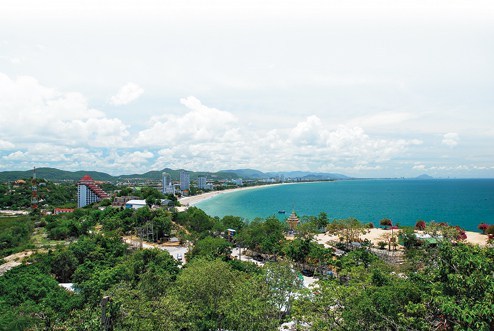
Hua Hin was once a tiny fishing village sitting pretty on silky white sands but it has grown hugely in the last 30 years.
In 1911, a rail connection was laid from Bangkok to Hua Hin. And on the tiny railway station, a beautiful pavilion in red and taupe was constructed as waiting room for the royals who arrived by train from Bangkok. Today, the classical Thai structure is a tourist attraction in itself and the station is reckoned to be one of Thailand’s most beautiful.
Over the next decade after the trains first puffed into Hua Hin, the fishing village metamorphosed into a buzzing royal resort and the Thai Royal State Railway decided to build a western-style hotel designed by an Italian architect. Bang opposite the station, it opened in 1923 as the Railway Hotel. Now the Sofitel Centara Grand Beach Resort & Villas, it became famous when the film The Killing Fields was shot there.
The Royal Hua Hin Golf Course and tennis courts also came up near the hotel to cater to the royal guests.
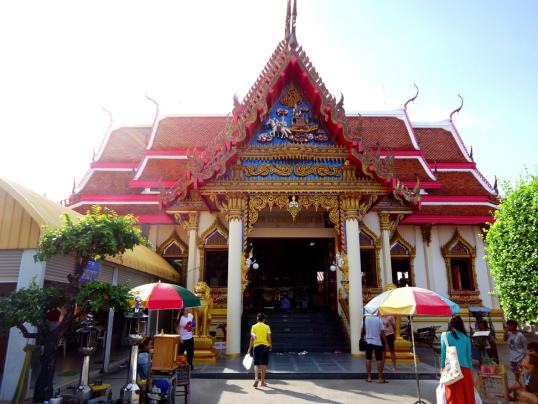
What began as a getaway town of the royalty and aristocracy, soon caught the imagination of the rich and famous and Hua Hin began catering to an exclusive set of visitors. And so began the trend of escaping from Bangkok’s crowds.
It was only in the 1980s that foreign travellers discovered this gem. A host of hotels sprang up to cater to the growing demand and lavish beach houses and condominiums were built all along the coastline. Today, the town has expats from several countries who’ve pretty much settled there. One estimate is that out of a total population of 80,000, almost 4,000 are foreigners.
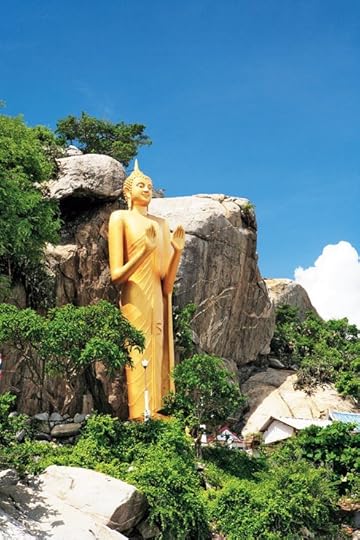
The giant standing Buddha at the Khao Tikiap Temple marks one end of Hat Hua Hin, the town’s five-mile-long beach. Photo: Tanushree Podder
The town’s key feature is Hat Hua Hin, a five-mile long stretch of fine, silvery sand. The lovely beach extends from a rocky promontory and undulates towards the feet of a Giant standing Buddha at the Khao Takiap temple.
The town’s night market is a delightful experience. It offers a multitude of shops selling all kinds of wares and tongue-tickling street food at affordable prices. Or, head to the Chatchai Market, where the local population shops for its supplies.
At a very different level, Cicada Market is one of Hua Hin’s unique institutions. It aims to bring together artists, art students, buyers, performers and connoisseurs. It offers everything from sculptures to paintings, traditional handicrafts and artefacts. It’s divided into four parts — Art a la Mode, Cicada Art Factory, Amphitheatre and Cicada Cuisine. The Art a la Mode has displays of clothes, artefacts and souvenirs and the Cicada Art Factory is where sculptures and paintings are shown. Exhibitions in this area feature young artists with unique ideas. At the Amphitheatre, one can catch traditional dance and music programmes on weekends.
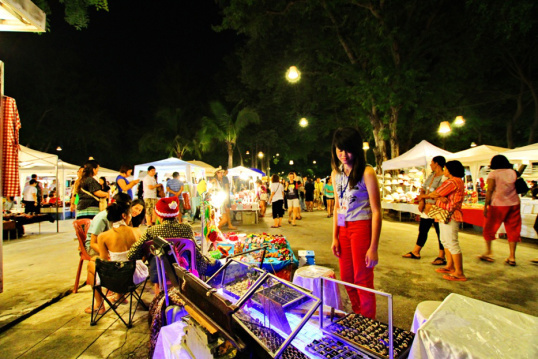
The Cicada Market
Khao Takiap, which translates to “Chopstick Hill”, is about 7 km from Hua Hin. It is a high promontory that protrudes proudly into the sea. Once a humble fishing village, it is slowly making the transition to beach town with several hotels and villas springing up on its periphery. Besides, a beautiful palm-fringed beach, the minuscule town has several temples among which the Khao Takiap Temple is the most famous. It has a mammoth golden statue of Buddha atop the hill. Most importantly, the hill offers a stunning panorama of the area.
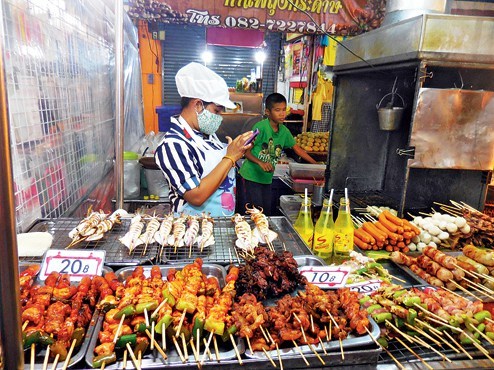
The town’s night market is a delightful experience with a spectacular variety of food on offer.
Photo: Tanushree Podder
Unlike Bangkok, Hua Hin does not boast of shopping malls, fancy res-taurants or architectural grandeur. Instead, it offers a promise of serenity and simplicity, away from the suffocating tourist hordes.
READY RECKONER
♦ How to get there: IndiGo, SpiceJet and Thai Airways fly from Calcutta to Bangkok. Hua Hin is another five hours by train or three hours away by bus or minivan from the capital.
♦ Where to stay: Options range from the 5-star Sofitel Centara Grand Beach Resort & Villas, to the affordable Hua Hin Grand Hotel and guesthouses.
♦ What to do: Enjoy the sea, shop for silks and jewellery, or Khommaphat print cottons.
(Published in The Telegraph, May 15, 2016)
Filed under: Travel, Wine and Cuisine Tagged: Bangkok, beach, Buddha, Chatchai Market, Chopstick Hill, Cicada Art Factory, Hat Hua Hin, Hua Hin, Khao Takiap temple, King Rama VI, King Rama VII, Marukatayawan Royal Palace, Pattaya, Phetchaburi, Phra Ratchawang Klai Kangwon, Phuket, Royal Hua Hin Golf Course, royal retreat, Thailand, The Killing Fields








May 3, 2016
A tale of two cities

The Ho Chi Minh Mausoleum
They’re two cities in the same country, just five hours apart by car — yet so different. While erstwhile Saigon, now known as Ho Chi Minh City, or by its initials, HCMC, wears its Western influence with aplomb, Vietnam’s capital, Hanoi, still retains a remarkably communist-era feel to it.
For a country ravaged by war, though, Vietnam has shown great resi-lience in recovering from its horrific past. Glimpses of the past can barely be seen, except in museums. What one experiences in Vietnam is a vibrant population, buzzing cities and miles of verdant fields dotted with conical hats in the countryside.
My journey began in Hanoi which is clearly a capital city. It was capital of French Indochina and then of Communist North Vietnam and remained a capital after reunification of North and South Vietnam in 1976. The city’s divided into two distinct parts — the Old Quarter and French Quarter. Colonial facades, tree-lined avenues, plush shopping arcades, luxurious hotels and boutiques populate the French Quarter while the narrow, labyrinthine lanes (collectively called 36 Streets) enliven the Old Quarter. For a traveller, there can be no bigger delight than frequenting both.
And those looking for the remnants of Vietnam’s communist past aren’t disappointed. Fluttering sickle-and-hammer flags, stern-faced policemen near key sites and blaring loudspeakers at street corners speak of the regimented life Hanoi citizens once led.
Nowhere is the regimentation more evident than when visiting the Ho Chi Minh Mausoleum. I joined a long queue of reverent locals eager for their rendezvous with “Uncle HO”. Bags were X-rayed, water bottles confiscated and strict instructions issued. Several white-uniformed soldiers kept a stern eye on the crawling queue.
A group of wide-eyed whispering students were hustled along with instructions to “keep quiet.” The snaking queue of visitors shuffled past the mummified body of a youthful-looking Ho. Someone whispered he’d just returned from his annual touch-up in Moscow where Russian leader Vladimir Lenin’s body is maintained by experts at a mausoleum in Red Square. A hushed silence, a few awed gasps and we were hurried out of the hallowed presence of the Father of Vietnam.

The Temple of Learning at Hanoi
I ran across another group of whispering students near the giant stone tortoises at the Temple of Literature, the first Vietnamese university, which dates back to 1076. It was exam time and the children were patting the
creatures for good luck.
Minutes later, hunger propelled me toward a horde of locals seated on plastic pavement stools. Slurping a bowlful of Pho, a rice-noodle meat broth that was delicious, fresh and inexpensive, I realised why Vietnamese cuisine is riding atop world culinary charts.
Then I was off to Hoan Kiem Lake, the city’s centrepiece and a popular spot for relaxing, where the proverbial golden dragon was spotted emerging from the water. Then, weaving my way through a crazily speeding tide of mopeds, skirting conical-hatted vendors, street-side diners and colourful cyclos, I made my way towards the Water Puppet Theatre to catch the unique show.

the ubiquitous cyclo
Next morning, driving through miles of green paddy fields, it was not difficult to see why the foreign powers had coveted the country. Lush and lovely, Vietnam is an artist’s dream. Then I arrived in Ho Chi Minh City, where I was greeted by soaring skyscrapers, imposing architecture, bustling avenues and another two-wheeler tide.
Saigon, as it was known during the Vietnam War, is the backdrop for many novels about the conflict on which I had grown up. I knew the American side of the war, but then I discovered the Vietnamese version at the war museum and visited the infamous Cu Chi Tunnels, a labyrinth of underground living quarters and Viet Cong supply routes.
Other than a few grim reminders of those turbulent years, HCMC is a vibrant, bustling and happy place where tourists flock to sample the delectable cuisine and cruise down the Mekong River. Life here’s faster-paced, busier and more cosmopolitan than in Hanoi.

The Opera House at Ho Chi Minh City
The imposing Reunification Palace, the Saigon Post Office designed by Gustave Eiffel, the French architect who also designed the Eiffel Tower, the lovely Opera House on Lam Son Square, the impressive City Hall and the Notre-Dame Basilica built with red bricks imported from Marseilles are all architectural masterpieces, reminders of the city’s colonial past.

Still functioning – The Saigon Post Office
Hanging around the Saigon River, it’s impossible to escape the city’s youthful energy. Throbbing music sets feet tapping at every square which come alive in the evenings. HCMC has come a long way since the war ended, although it’s still possible to revisit those times. All one has to do is to step into the Continental Hotel where Graham Greene holed up to work on his book The Quiet American, or enter the Caravelle Hotel, the war correspondents’ watering-hole.
Competitive, brash, young, vibrant, irreverent — that’s what describes Ho Chi Minh City. Traditional, restrained — that’s Hanoi. That said, it’s difficult not to be charmed by both cities or come back untouched.
READY RECKONER
♦ How to get there: From Calcutta, both Ho Chi Minh City and Hanoi are one-stop flights away on Thai Airways.
♦ Where to stay: There are hundreds of affordable options. In Hanoi, staying in the Old Quarter is cheaper than in the French Quarter. In Ho Chi Minh City, try the five-star Hotel Continental or the three-star Sunland Hotel.
♦ What to do: Go on a cruise on the Mekong River, visit Halong Bay and the Cu Chi Tunnels. Savour the street food and Vietnamese coffee.
(Published in The Telegraph, April 24, 2016)
Filed under: Travel, Wine and Cuisine Tagged: City Hall, French Quarter, Hanoi, Ho Chi Minh City, Ho Chi Minh Mausoleum, Hoan Kiem Lake, Lam Son Square, Old Quarter, Pho, Reunification Palace, Saigon, Saigon Post Office, Saigon River, Vietnam, Vietnam War, Water Puppet Theatre








City with a past
A few decades ago, Vietnam was known to people as a place where a devastating and long war had been fought. It was the story of David taking on Goliath, where the poor and ill-armed Vietnamese fought persistently with a well-armed and sophisticated American army. What is more, they managed to chase them away.
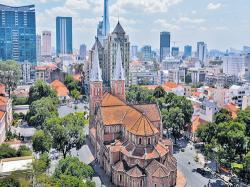
A bird’s eye view of the city
That was the past of a city known as Saigon. Not too long ago, the city’s name was changed from Saigon to Ho Chi Minh. Nevertheless, many old timers still refer to it as Saigon. For the younger generation, it is HCMC, a shortened form of the tongue-twisting Ho Chi Minh City. Today, HCMC is one of the most popular tourist destinations of Asia. Hordes of travellers descend on it every year, and go back enchanted by the sights, cuisine and people.
Eventful history

The Saigon Post Office
From a French Colonial identity to a war-ravaged city to a business capital, HCMC has come a long way. The French has crowned the city as the capital of South Vietnam. They called it the Pearl of the Orient and left their footprints in the form of a beautiful Opera House, City Hall, Basilica and the Central Post Office (designed by none other than Gustave Eiffel of the Eiffel Tower fame), all constructed in the classic French colonial architecture. The broad boulevards stretching up to the Saigon River, several stucco villas and a hotel known as Hotel de Ville are some other remnants of the colonial era.
The reminders of the war have not been completely obliterated. They still stand in the city, in the form of the war museums, as a memento of those horrifying years. These are more of interest to the tourists and serve as an educational experience for the students. Lest they forget the historic struggle of their forefathers. The famous Reunion Palace is one of the compelling symbols of the Vietnam War. Also known as the Independence Palace, it stands where the grand Palais Norodom stood before it was bombed and destroyed. The warren of war rooms, communication rooms and telecommunication control room underground are a total anomaly to the lavish reception rooms, grand living areas, bars and party rooms on the upper floors.
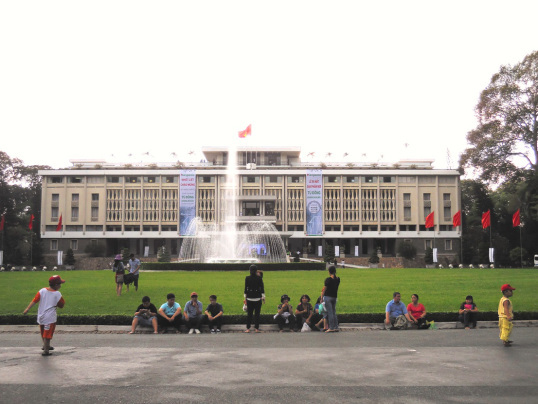
Reunification Palace
Those who are not squeamish can visit the War Remnants Museum. Graphic pictures of dead children, mutilated bodies and other war crimes are exhibited in this museum along with those of war equipment. For the rest, a short tour of the Vietnam National History Museum should suffice. Located in the lush area between the Botanical Gardens and Saigon Zoo, the museum is an introduction to the country’s history right from the times of Champa Kingdom to the modern time.
There is an unmistakable influence of the Chinese occupation on the city. Some of the finest pagodas can be found here. Right from food to culture, gardens and temples, the influence is scattered all over the city, more so in the Cholon area, which is HCMC’s very own Chinatown.
HCMC is a city of contrasts. It is possible to traverse from the elegant colonial structures to the tranquil pagodas and lush parks to the mad snarl of traffic in a matter of minutes. As the sun sets, coloured fountains come alive on the enormous lit up squares along with the foot-tapping music.
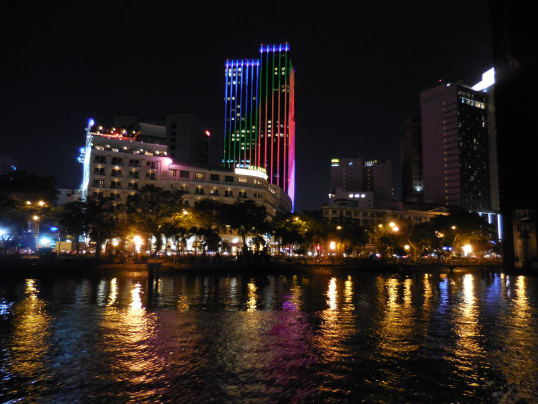
Saigon River by night
It is a young city in many ways, with most of its population born in the 70s, and the average age being 29. On most evenings, the Saigon River is where the action is. With crowds of young couples sitting around the river bank, it is a vibrant place. Dozens of tourist-laden boats cruise down the river. On the banks stands the Majestic Hotel, where Graham Greene sat staring at the gently flowing river as he plotted his well-known novel The Quiet American.

A vendor
Street surprise
Exotic street food is what draws many tourists to Vietnam. Every other alleyway and street is crowded with food stalls. The Vietnamese are complete foodies, given to detailed discussions on food and drinks. Come evening and the small plastic stools crowd the pavements, as people swap gossip and news, slurp soups and gulp down Vietnamese beer or coffee. The last item is much like the filter coffee of our country, made in similar contraption. Speak to a tourist and he is sure to rave about the Vietnamese coffee. Pho, a delicious soup of noodles and meat, is as popular with the tourists as the crusty French baguettes and pastries (remnants of French influence) that remain city’s speciality.
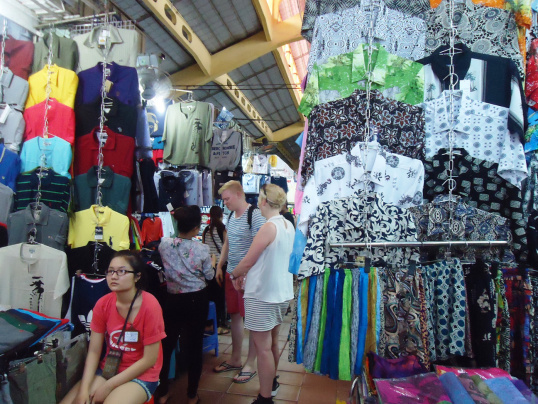
The busy Ben Thanh Market
Shopping is never far from a tourist’s mind. For such minds, HCMC is a veritable paradise. The bustling Ben Thanh Market is where they converge for their shopping spree. From textiles to tobacco and spices, almost everything is stocked in the cornucopia of tiny stalls. There are also food stalls, should you feel the hunger pangs after brisk bargaining, which is almost mandatory. For those who need another venue for shopping, there is the Binh Tay market. Located in the Chinatown, it was established by a Chinese entrepreneur named Quach Dam. Binh Tay, with its 2,000-plus stalls, is a noisy and chaotic place but it is also a place that has a food court, which serves fantastic fare.
Most visitors to HCMC go back with the image of a pulsating, warm and spirited city. Undeniably, HCMC is a city with a soul and a warm one at that.
Fact file
Getting there: Many airlines like Vietnam Airways, Thai Airways, Singapore Airlines and Jet Airways fly from India to Hanoi.
Stay: Compared to many foreign destinations, Vietnam is quite affordable. At HCMC, one could very well book in a 5-star hotel like Hotel Continental for a pleasingly low tariff. For those looking for cheaper stay options, there are several B&Bs and hostels around the city.
Food: Street food is inexpensive, provided you are willing to sit on a plastic stool on the street-side and enjoy it with the locals. Vietnam is a veritable paradise for sea-food lovers.
Shopping: Silks, ceramics, black-and-red lacquer ware, wood carvings and bamboo artefacts are some of the most popular shopping items. The local silk dress ao dai is a must-buy.
Currency: The Vietnamese dong is essential, although you can convert US dollars in many places.
(Published in Sunday Herald, May 1, 2016)
Filed under: Travel, Wine and Cuisine Tagged: Ben Thanh Market, Binh Tay market, Cholon area, David, Goliath, Ho Chi Minh, Ho Chi Minh City, Hotel de Ville, lacquer ware, Opera House, Palais Norodom, Pho, Reunion Palace, Saigon, Saigon River, Vietnam, Vietnam National History Museum, Vietnam War, War Remnants Museum








March 22, 2016
Apple tea, Turkish coffee and nazar
I saw one dangling before my eyes as I boarded the bus that was to take me to my destination. Another one caught my eye as I sat in a café enjoying a strong cup of Turkish coffee. A key chain sticking out of a man’s pocket also sported it. Yet another lay embedded on the pavement in front of the shop where I bought my first souvenir. They were everywhere, those blue and white concentric circles painted on a deep blue glass surface; you just can’t escape them when you are in Turkey. I am talking about the ubiquitous Turkish nazar.
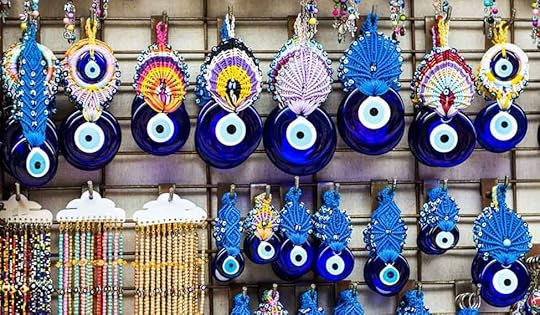
the Turkish nazars
There are two things that one is likely to run into repeatedly in the country; the nazar and the simit sellers (simit is a delicious, ring-like baked pastry studded with sesame seeds).
“Marhaba,” greeted a shopkeeper as I negotiated the cobble-stoned street. “Pakistan?” He asked.
“India,” I smiled and he grinned back happily.
I came across welcome smiles and bonhomie wherever I went. Schoolchildren greeted me with beaming smiles and warm ‘Hello’ as I queued up to enter the Topkapi Palace.
The salesman in a carpet shop offered me apple tea with a plateful of Turkish Delight (a sweet) even as he smilingly unrolled dozens of his beautiful ware.
The hospitality and warmth overruled the language problem. Very few people speak English but they convey a sense of happiness quite easily. I enjoyed endless cups of the fragrant and fruity apple tea wherever I went. The tea is addictive and so is the Turkish cheer.
Istanbul to me, like the stories from the Arabian Nights, was a city of many fables and mysteries. Standing in the centre of the Sultanahmet Square, I tried to come to terms with the glory of the historic city that went by the name Constantinople during the days of the Byzantine Empire. Sultanahmet is like a postcard picture, with the minarets and blue domes dotting the skyline.
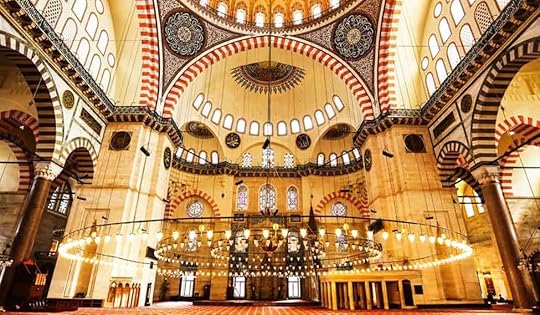
Interior of Suleymaniye Mosque, the largest mosque in Istanbul, which was built in 1550-1580 by Ottoman architect Mimar Sinan | Thipjang
Spread out before my wondering eyes was the Blue Mosque on one side. With an interior that is gold and blue, it is one of the most magnificent structures in the city.
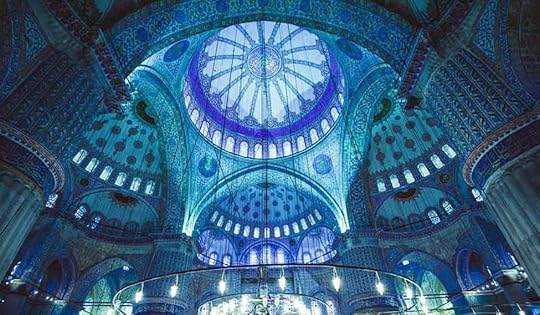
Sultan Ahmed Mosque or Sultan Ahmet Mosque popularly known as the Blue Mosque in Istanbul
Once the venue for chariot races (the kind you saw in Ben Hur), the ancient Hippodrome has so many stories to narrate. Its crumbling city walls carry the heaviness of umpteen wars and victories.
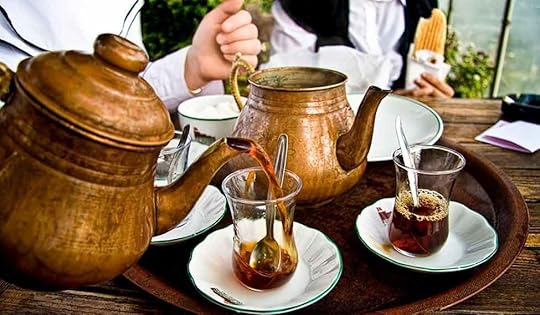
Apple tea
Across the square, I entered the majestic Topkapi Palace and gaped through the glass windows. My eyes dazzled with the brilliance of the crown jewels and riches. The beautiful blue and white tiles of the harem echoed with the stifled sobs and delightful giggles of the concubines from the Ottoman times. The Prophet’s mantle and David’s Staff humbled me as I walked enraptured through the Sacred Relics section in the Topkapi Palace Museum. There was a sense of travelling back in time as I took in the beauty of the imperial pavilion, its gilded walls interspersed with exquisite Izmik tiles. The Fruit Room, with its tempting offerings took my breath away.
All around me were superb creations spun with luxuriant tones that come with power and money; the entire palace was a wonderland through which I wandered much like the proverbial Alice, halting and gaping, in awe.
The Hagia Sofya, now known as Aya Sofya Museum, a marvellous contribution of a Byzantine Emperor to the world of architecture, stood saddled with ugly iron scaffolding as restoration was in progress. Its beautiful interiors were dark and depressing as I tried to adjust my weak eyesight to the creative brilliance of the mosaic work. Once a church, then a mosque and now a museum, it is the most hallowed place in the city.

Medusa head in the Basilica Cistern in Istanbul, Turkey. It is a 143m long and 65m wide underground water container | S-F
The Underground Cistern, with mammoth columns, cool and dark interiors and the famous Medusa head, is a maze. During the Byzantine times it was called Basilica Cistern but the Turks call it the Yerebatan Sarayi (Sunken Palace). It was through this maze that James Bond canoed his way in From Russia with Love.
My trip to the greatest covered bazaar in the world, the Grand Bazaar, known as Kapali Çarsi by the locals turned out as fascinating as I had expected. Colourful kilims (flat tapestry-woven carpets or rugs) rubbed fringes with belly dancer costumes, exquisite ceramic ware stood alongside brass and copperware, Turkish çay (tea) sets in cut glass reflected the coloured lights, Turkish delight sweets and apple tea, trinkets and jewellery… the endless shops flowed over with their merchandise. It was like Chandni Chowk, with labyrinths leading to yet more shops.

The Gate of the Sultan, Dolmabahce Palace, Istanbul
The Spice Market, with its heaps of turmeric, pepper, garam masala and the ubiquitous Indian curry powder, smelled like the spice street in Kochi. Surprisingly, the pleasure of bargaining, despite the language hurdle, wasn’t denied to me in Istanbul. Munching the delicious roasted chestnuts from a paper bag, I launched upon my favourite pastime and bagged a dozen of Turkish nazar to gift folks back home.
That night, as I joined a multitude of revellers on the Istiklal Street, a group of young Turks danced around their vehicles to celebrate the end of their one year compulsory army conscription. The street was pulsating with energy as the young and the not-so-young crowded the night clubs. Coming upon a restaurant that advertised belly dancing on the menu, I entered the dimly-lit place that was bursting at seams with eager tourists. Waiters bustled about serving a four-course meal amid the loud chatter.
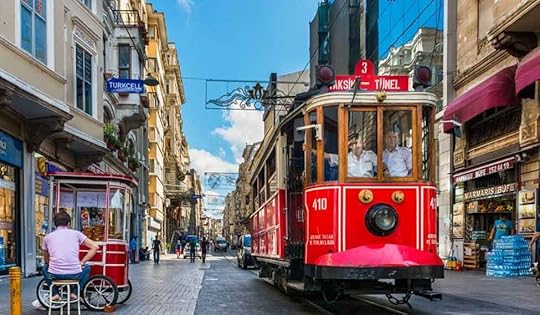
The Taksim-Tunel Nostalgia Tram trundles along the streets of Taksim in Istanbul | Vincent St. Thomas
The music began, the noise levels came down and all eyes turned towards the stage in the centre. First, a martial band romped on the scene, dressed in traditional costume and then there was a fire eater to amuse the restive crowd, which was waiting for the highlight of the evening. In what seemed to be a test of audience’s patience, a series of dancers came and performed but the belly dancer was nowhere to be seen. By now a group of inebriated Russians had begun thumping their table. Helping myself to a large serving of baklava, I waited, too.
The lights dimmed further and to the roll of drums the scantily-clad belly dancer swayed sexily up the ramp and the audience went into rapture. As she went into complicated gyrations, I mulled over the dream world that is Istanbul.
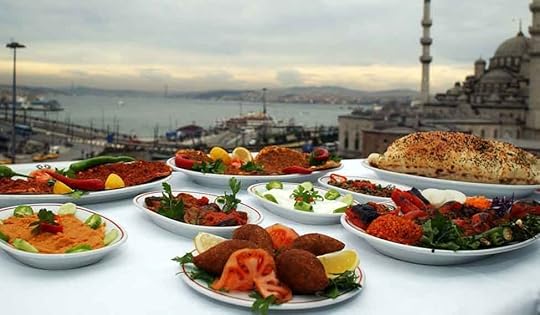
Turkish dishes in a restaurant at the Eminonu square in Istanbul | Thomas Koch
Food
The kebabs and simit are simply delicious. For the fish lovers, Istanbul is a veritable heaven—the grilled sea bass along with mackerels, mussels and shrimps make a tempting menu. The olives are to die for and so are the aubergine delicacies and the roasted tomatoes. Down it all with the local brew called raki and sample the baklava as the grand finale.
While in Istanbul you can choose to stay in the Old City or the newer parts. If you are on a sightseeing spree, staying in the Old City would be more convenient. If you have deep pockets, go for Ottoman Hotel Imperial or Almina Hotel (4-star boutique hotel). For those on a tight budget, Cordial House Hotel or Medussa Hotel would be perfect.

Stalls selling spices in the Spice Bazaar in Istanbul
Shopping
The Grand Bazar with its 4,000 shops and the Spice Bazar are the ideal places to shop for wood inlay worked bric brac, brass and copper ware, beautiful ceramic articles, kilims and sheeshas. Don’t forget to splurge on apple and rose tea and Turkish Delight. The local wines are a good buy if you are a wine lover.
How to reach
Turkish Airlines has regular flights between Delhi, Mumbai and Istanbul.
(Published in The Week, March 27, 2016)
Filed under: Travel, Wine and Cuisine Tagged: apple tea, baklava, Basilica Cistern, Blue Mosque, Byzantine Emperor, Dolmabahce Palace, Grand Bazaar, Hagia Sofya, Istanbul, Istiklal Street, Izmik tiles, kebabs, Marhaba, Old City, Ottoman Palaces, raki, simit, Spice Bazaar, Sultanahmet Square, Taksim, Topkapi, Turkey, Turkish çay, Turkish Baths, turkish coffee, Underground Cistern








March 21, 2016
A forgotten royal jewel
I could never understand why it was called Orchha, or the Hidden One. Founded by the Bundelas in the 16th century, the capital city, situated on the banks of the Betwa river, is one of the most beautiful places in the region that should not be hidden. Stories of valour, romance and revenge resound in the walls of the structures that line the river bank. This was once the land of warriors.
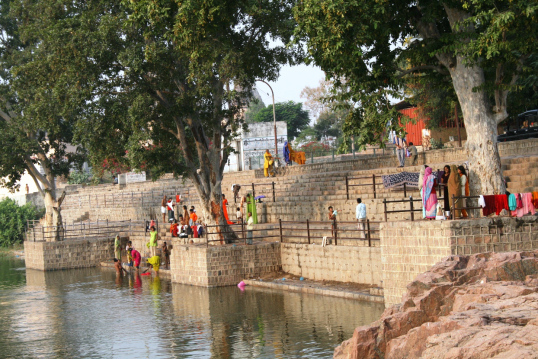
On the bank of Betwa River
As one crosses the ancient stone bridge, a clutch of palaces loom up in the distance, some of them in ruins. Within the ancient city wall, on the fortified part of Orchha stand magnificent palaces with winding corridors, cool halls, lofty pillars, windy terraces reached by spiral stairways. Most of them are in disrepair, today. Myth and stories prevail, pride wells up in eyes as locals narrate tales of past glory and Bundela valour to the travellers. The dusty surroundings notwithstanding, Orchha is a striking place.
Historic significance
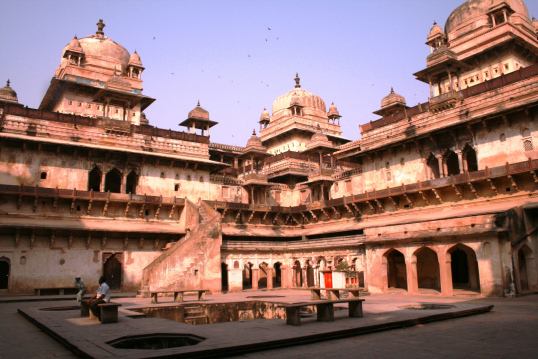
Jahangir Mahal
Jahangir Palace is easily the most impressive one of the lot. The palace is said to have been constructed by Raja Bir Singh Ju Deo to celebrate the visit of Emperor Jehangir to Orchha.
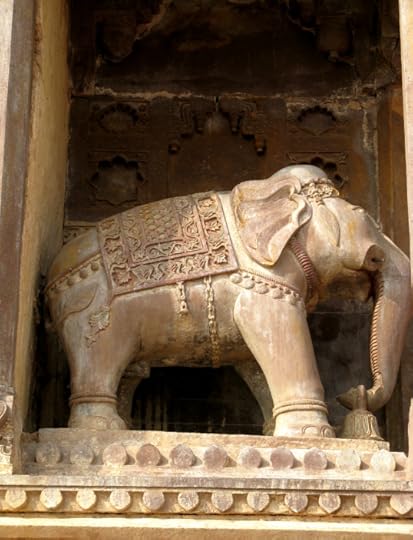
A pair of stone elephants at the entrance lend it a distinctive touch. The palace, constructed in Indo-Islamic architectural style, once had a blue tiled facade, I was told. Not many remain today. Large airy halls, sunny terraces, balconies and pierced stone screens formed can be seen in the royal palace. Some of the rooms were covered with murals. Most of the murals have faded, leaving behind blurred pictures of a glorious past.
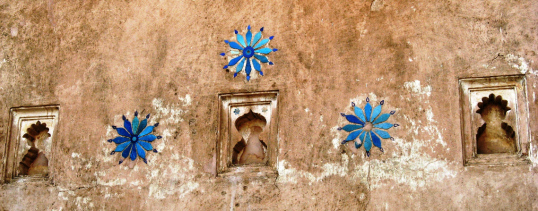
Once upon a time, the facade was studded with blue tiles
The Raj Mahal is one of the oldest palaces in the complex. With its exquisite frescoes depicting Krishna’s antics, it was once a very impressive palace. There are distinctive royal quarters, romantic balconies and labyrinthine passages that echo with mysterious tales.
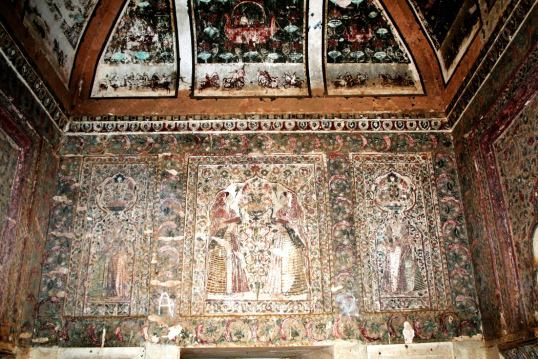
Exquisite murals on the walls
Sheesh Mahals must have been a status symbol for the kings, at one time in history. These mirrored halls formed an important part of the Mughal as well as Rajput palaces. Same is the case with Bundela kings. Orchha has a Sheesh Mahal, too. Remnants of the mirror inlay on the walls reflect its past glory.
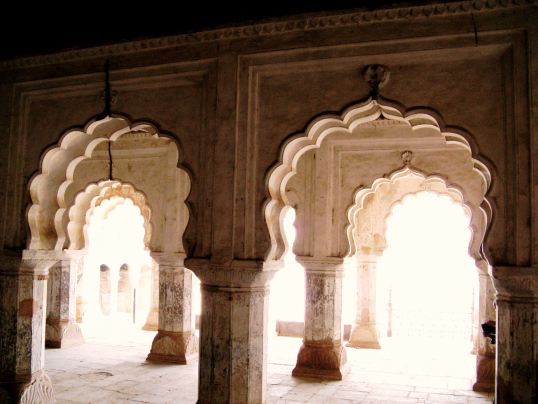
Diwan e Aam
Set amidst a sprawling garden, the small two-storeyed Rai Praveen Mahal has a romantic story to narrate. The charming garden mansion was constructed for Rai Parveen, the beautiful concubine of Raja Indramani. The Raja adored her. She was an accomplished poetess, dancer and singer. It is said that Mughal Emperor Akbar, impressed by stories of her beauty and talent, summoned her to Agra. The intentions were not honourable, but the Bundela king could not refuse the order. He was but a subject of the mighty emperor. The concubine, however, was an intelligent woman. A poem was composed. In cleverly-worded verse, she conveyed that it didn’t behove an emperor to settle for leftovers. Realising his folly, the emperor sent Rai Parveen back to the Bundela king. Folklores narrate the tale of their love, even today.
The temple complex is as impressive as the palace complex. Right at the end of a small market stands Ram Raja Mandir. According to a legend, king Madhukar Shah decided to construct a temple for Lord Ram. An idol of the deity was brought from Ayodhya and placed in the palace while the temple construction took place. One night, the queen, a devotee of Ram, had a dream wherein she was ordered to let the idol to remain in the palace.
Glorious shrines
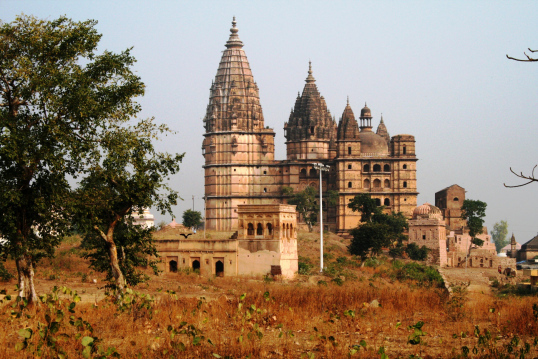
Chaturbhuj Temple
After the completion of the temple, when the priests tried to remove the idol from the palace, they just couldn’t move it. A part of the palace was turned into a temple and the idol continued to remain there. As a result, the Chaturbhuj Temple, which was constructed to house the idol, continues to remain empty.
The Lakshmi Narayan temple is known for its beautiful murals, which time has not been able to fade. The vivid colours of the beautiful paintings still remain as fresh.
The Phool Bagh was once an oasis of green amidst the ruins. Today, the garden is struggling to remain green. An 8-pillared palace, known as the Dinman Hardaul Palace, stands near the fountains. The garden with its fountains and greenery, once served as the summer retreat for the Bundela kings, but the Hardaul Palace has a tragic story to narrate. Prince Hardaul, the younger son of King Bir Singh Ju, was accused of romancing the elder brother’s wife.
The valiant prince, unable to bear the charge, committed suicide to prove his innocence.
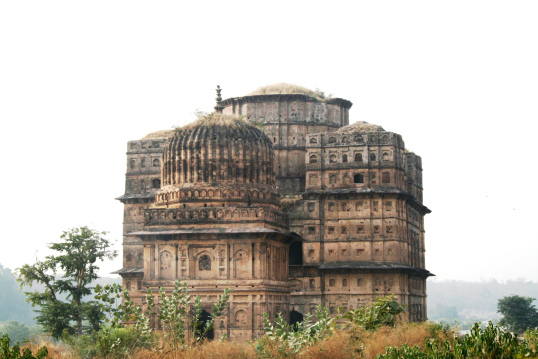
a beautiful cenotaph
A clutch of cenotaphs stand forlornly on the banks of Betwa. These exquisitely designed cenotaphs of Bundela kings and their kin reflect the fine architecture of the region. As the sun sets, its last rays are reflected in the Betwa and the backdrop of chhatris form an arresting visual that no camera can capture.
Frozen in time, Orchha’s structures echo stories of people who lived and loved, warred and died on the banks of Betwa.
Reaching There
By Air – The nearest airport is at Gwalior, which is about 120 km away.
By Rail – The nearest railhead is at Jhansi, which is 16 km away.
For Stay
Two hotels run by Madhya Pradesh Tourism Development
Corporation (MPTDC) are the best bet.
(Published in Sunday Herald, March 20, 2016)
Filed under: Travel Tagged: Ayodhya, Betwa River, Bundela, cenotaph, Chaturbhuj Temple, concubine, Emperor Akbar, Gwalior, India, Indo-Islamic architecture, Jahangir Palace, Jhansi, Lakshmi Narayan temple, Madhukar Shah, Madhya Pradesh, MPTDC, Murals, Orchha, Phool Bagh, Prince Hardaul, Rai Praveen Mahal, Raja Bir Singh Ju Deo, Raja Indramani, Ram Raja Mandir, Sheesh Mahal








On a light note
Hundreds of lanterns lit up the sky during the fascinating Lantern Festival in Taiwan

Each year on the fifteenth night of the first lunar month, the tiny country known as Taiwan comes alive with thousands of lanterns lighting the sky. Once named Formosa, which means beautiful, in Portuguese, Taiwan adorns itself with lights during the lantern festival. The sky is lit up with hundreds of lanterns and bursting crackers, to the accompaniment of loud cheering by the people who gather each year to celebrate the festival.The Lantern Festival of Taiwan is a fascinating experience. Since red is considered an auspicious colour, lanterns made in red dot the sky. The festival, an ancient Chinese tradition, dates back to more than 2000 years but it is still celebrated with gusto at Taiwan. Held on the last day of the Chinese New Year celebrations, the entire city is dressed up with lights and a festive mood prevails.

There are umpteen legends about the origin of the festival. According to one of these, the lantern festival began during the reign of a Han dynasty emperor. His subjects were asked to light up the kingdom on the fifteenth night of the first lunar year. The emperor, being a Buddhist, wanted this done as an honour to Buddha. It was also said the light from the lanterns enabled people to see the deities as they descended to earth to bless the devout.Another legend puts the origin of the festival during the rule of the Tang dynasty.
Yet another legend links the festival to the god of good fortune, whose birthday falls on the fifteenth day of first lunar month. The God, Tianguan, is believed to love all kinds of entertainment so the believers put up a show of light, firecrackers and riddles.Whatever be the origin or the reason, the lantern festival has developed into one of the major festivals in Taiwan.Although it began as a religious festival, the lantern festival now holds many interesting events.
One of them is the riddle contest where riddles connected with the festival and lantern are solved by the participants. Each year, a giant lantern in the shape of the animal that represents that year according to the Chinese zodiac signs, is installed in the plaza of the Chiang Kai-shek Memorial Hall. This year being the Year of the Monkey according to the Chinese zodiac calendar, a monkey shaped, gigantic lantern had been installed right in front of the Taoyuan station to celebrate the Lantern Festival.
There are acrobatic shows, dragon dances, traditional drama and mock battles. Dozens of stalls with handicrafts, lanterns and sweets dot the lanes. Almost every Taiwanese is out in the streets enjoying the festival.A special sweet called the Tangyuan is prepared in all Taiwanese homes during the lantern festival. It is made of glutinous rice and has a filling of sesame paste, sweet red bean paste or peanut butter. Tangyuan is shaped like a ball since a round shape is supposed to symbolise good fortune and harmony.

Filed under: Travel, Wine and Cuisine Tagged: Buddha, Chiang Kai-shek Memorial Hall, Chinese, Chinese New Year, Formosa, Han dynasty, lantern festival, Taiwan, Taoyuan, Tianguan



















